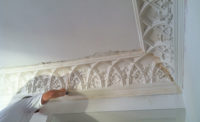The Master of Plaster Conservation








The next time you’re in a century-old building, tilt your head up for a moment and have a look at the ceiling. It’s probably made of plaster on wood lath. The surface of the plaster may be plain-face or ornately embellished with decorative paint. It may strike you as beautiful or mundane. Either way, what may appear to be just another ceiling is actually a brilliantly conceived and counter-intuitive piece of mechanical engineering, a shining example of craftsmanship, and an important part of our architectural heritage.
Plaster on wood lath was the dominant fabric of choice for ceilings and walls in buildings constructed in North America during the 19th century. While fairly strong and durable, these ceilings and walls are not immune to the ravages of time. Year after year, for decade upon decade, they experience myriad stresses caused by structural overloading, building micro-movements, installation of mechanical systems, moisture vapor transmission and water infiltration.
It’s not surprising then that plaster failure is an endemic problem amongst thousands of important buildings across America. After over 100 years, all of these ceilings have reached their “best before” date. Indeed, there have been numerous collapses of plaster over the past 50 years and unless some serious preventative maintenance is undertaken, there are many more to come. The question is not whether any particular ceiling will fail—the question is when?
Wood Lath Ceilings
In the spring of 1980, Morgan Phillips, a pioneer in the field of architectural conservation and an innovator in historic building preservation, published a seminal paper in the Association of Preservation Technology Bulletin, titled “Adhesives for the Reattachment of Loose Plaster.” The paper describes the role of plaster-on-wood-lath as an early architectural material and the problem of plaster falling away from ceilings and walls.
After reviewing the drawbacks of previous methods and techniques used to reattach loose plaster to wood substrates, Phillips presented a new approach involving the injection of “specially formulated acrylic-resin-based adhesives into the space between the lath and plaster, through holes drilled either through the plaster or, where the reverse side is accessible, through the laths or other substrate.” The objective was to reattach the plaster with a strong bond between the plaster and the wood lath substrate. Two types of adhesives were recommended: an unfilled formulation designed for easy injection into narrow spaces, and a filled material to address larger gaps between the plaster and substrate. It was a revolutionary idea.
Born in New Rochelle, N.Y., Phillips attended Yale as an undergraduate before becoming one of the first graduates from Columbia University’s MA program in Historic Preservation. In the late 1960s, he joined the staff of the Society for the Preservation of New England Antiquities where he spent 22 years addressing problems of the Society’s historic buildings. With no formal training in science, technology or craftsmanship, he was largely self-taught but developed a remarkable facility for solving complicated conservation problems using simple, readily available materials. He pioneered a number of techniques that became standard in the field, including the microscopic examination of historic paint layers, the replication of historic masonry mortars, and the treatment of wood with epoxies—all techniques and methods that we take for granted today.
It was totally in character then for Phillips to come up with a new and relatively simple method for reattaching loose plaster with the injection of acrylic resins, one that was eminently sensible and, compared with previous methods of plaster repair, even elegant.
In presenting this new method, Phillips stated that it showed promising results in a few trial applications but openly acknowledged that it had not yet been extensively tested. After going into considerable and highly instructive detail on the formulations and methodology of using acrylic resins to reattach plaster, he concluded by stating that the “suggested formulations can undoubtedly be improved through more methodical programs of testing and through critical observation of their performance in actual applications.” And finally, in his typically collegial way, he encouraged people to try out his new methodology and provide feedback, regardless of the results.
The Legend of Phillips
A few years after the Phillips article was published, Roderick (“Rod”) Stewart was in the midst of assessing various problems in an 1817 structure called Barnum House in the Canadian rural town of Grafton, Ontario. Stewart was operating a carriage trade construction company, specializing in historic house restoration in nearby Port Hope, a town known for its architectural heritage
Barnum House is a frame Greek revival house and the first house in Canada to be purchased by an historical society for the purpose of turning it into a historic house museum and for that reason was designated a national historic site. Built by a United Empire Loyalist, the house is now owned by the Ontario Heritage Trust (formerly the Ontario Heritage Foundation), a provincial government agency.
The man responsible for overseeing the preservation of Barnum House was Herb Stovel, one of the world’s most renowned experts in heritage conservation. A former president of the Association of Preservation Technology and Secretary-General of ICOMOS international, Stovel was a scholar and teacher of exceptional intellectual curiosity and rigour.
“Herb Stovel was a giant in his field and a genuine mentor to me,” says Stewart. “His inspiration and guidance are the reasons I became interested in heritage conservation.”
At Barnum House, Stovel observed that there was a serious problem with the plaster ceilings, and asked Stewart to have a look, handing him the Phillips paper from the APT Bulletin.
“Read this and tell me what you think,” Stovel instructed. “We may want to experiment with some of the adhesives on this plaster.”
Where Plaster Consolidation Was Born
Stewart was born in 1947 in Brantford, Ontario and raised in nearby Dundas. Stewart quit high school at age 17 and went back in his early 20’s to qualify for university. He completed the final four high school grades in one year and then was accepted to Hamilton’s McMaster University where he quit after two weeks. He managed to stay in the university community by getting hired as a photographer for the newly acquire Bertand Russell archives. He also became interested in theatre at McMaster, eventually forming his own avant-garde theatre group that toured the northeastern seaboard of the United States, entertaining gatherings of anti-war protesters on university campuses with the left-leaning didactic plays of Bertolt Brecht.
When avant-garde theatre ran its course, Stewart moved to Port Hope (60 miles east of Toronto) where he evolved into a hippie farmer, keeping bees and raising chickens.
The need for more gainful employment prompted Stewart to take up carpentry. After completing an untraditional apprenticeship, he soon concluded that while carpentry is a fine and demanding trade, it was being degraded by the modern way buildings were constructed. There was less and less quality in the materials being used, less requirement for trade skills and more installation of commodities from hardware stores and lumberyards. This prompted Stewart to specialize in historic house renovations where the materials of these original buildings were of high quality. “Many lessons can be learned by looking closely at how things were done in the past,” Stewart says. He soon became a leader in the field.
Upon reading the Phillips paper, Stewart was eager to give the prescribed methodology and materials a try. “I was very enthused to be able to experiment with leading-edge technology on an important building.”
Along with Adam Zelinski, an engineer and scientific mind assigned by Stovel from the resources of the Ontario Heritage Foundation, they began by choosing an out-of-the-way space in the Barnum House to conduct some experiments. “Our single objective was to prove Morgan Phillips right,” Stewart recalls. “We made sure to carefully follow his instructions and conduct the tests exactly as he prescribed.”
The initial results, however, were mixed. On the positive side, Phillips’ recommendation to use acrylic resins as a bonding agent was brilliant—they worked like a charm. On the negative side, there was a severe limitation to what he had proposed. As Stewart explains, “Phillips’ method was ideal for addressing a localized problem in a small isolated area of the plaster but it did very little to address the entire plaster ceiling system.”
The concept of a plaster-on-wood-lath ceiling being a “system” would soon become the cornerstone of Stewart’s plaster conservation thinking, governing the way he both assesses and treats plaster. To appreciate how a plaster ceiling functions as a system, one must first understand the ingenious way it was mechanically engineered. Here’s a brief primer on how a mid-19th century wood lath and plaster ceiling was made:
First, narrow strips of wood called laths were nailed horizontally across the ceiling joists, with a 3/8-inch gap between the strips of lath. Using a wood float or trowel, the tradesman would apply a base coat of sloppy wet plaster by slowly dragging the tool across the face of the laths. With considerable strength, he would push and extrude the plaster through each gap between the laths so that the plaster would “slump” over on top of the back of the wood lath, forming a “key and lug” that would act as a “hook” to create a suspended system. When the plasterer was finished, literally thousands of these keys and lugs would be working together to hold the ceiling in place.
What makes a wood lath and plaster ceiling an ingenious piece of mechanical engineering is that it is deliberately designed to be loosely suspended from and not directly attached or bonded to the wood lath substrate. This is why the strips of wood lath were soaking wet or green when the plaster was applied. When the lath dried it would shrink away from the plaster, giving the ceiling the looseness, resilience and structural flexibility it needs to withstand the building’s micro-movements without cracking the brittle plaster.
Next time, we’ll explore how a plaster ceiling is converted from a fragile loosely suspended system into a strong unified adhered system.
Looking for a reprint of this article?
From high-res PDFs to custom plaques, order your copy today!












